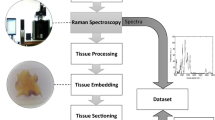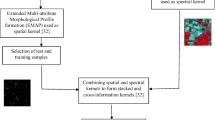Abstract
Biological tissues are the basic components that constitute the structure of all living organisms. There are many types and complex internal components. The effective identification of different types of biological tissues is of great significance for the diagnosis of human diseases and the safe intake of animal-derived foods. Due to the similarities and differences in the elements in different types of biological tissues, this paper focuses on how to extract element characteristics in the same type of tissue for micro-difference identification. Based on the completion of the system construction, in view of the complexity, specificity and high-dimensionality of biological tissue spectral data, combined with machine learning methods, useful information is extracted from complex spectral data and a more robust analysis model is established. And improve the algorithm to improve its analysis performance. Because the surface of biological tissue samples has the characteristics of unevenness, cracks, and softness at room temperature, the experiment needs to precisely control the position of the laser focus relative to the surface of the sample, so as to achieve precise control of the laser pulse direction and laser focusing. The final results of the research show that the spectral recognition accuracy and accuracy of PC1 are 93.61% and 95.65%, respectively, and the spectral recognition accuracy and accuracy of PC2 are 87.56% and 98.46%, respectively. The spectral recognition accuracy can reach more than 85%, and the accuracy rate is %. Can reach more than 90%.
Access this chapter
Tax calculation will be finalised at checkout
Purchases are for personal use only
Similar content being viewed by others
References
Vishnuvarthanan, A., Rajasekaran, M.P., Govindaraj, V., et al.: An automated hybrid approach using clustering and nature inspired optimization technique for improved tumor and tissue segmentation in magnetic resonance brain images. Appl. Soft Comput. 57, 399–426 (2017)
Hailin, H.E., Zheng, J., Fangli, Y.U., et al.: Exoskeleton robot gait detection based on improved whale optimization algorithm. J. Comput. Appl. 5(82), 45–53 (2019)
Vishnuvarthanan, A., Govindara, V., et al.: An automated hybrid approach using clustering and nature inspired optimization technique for improved tumor and tissue segmentation in magnetic resonance brain images. Appl. Soft Comput. 57, 399–426 (2017)
Rossi, R., Fang, M., Zhu, L., et al.: Calculating and comparing codon usage values in rare disease genes highlights codon clustering with disease-and tissue- specific hierarchy. PLoS ONE 2(17), 1–22 (2022)
Kerkel, L., Seunarine, K., Henriques, R.N., et al.: Improved reproducibility of diffusion kurtosis imaging using regularized non-linear optimization informed by artificial neural networks. 74(1), 15–30 (2022)
Kasturi, S.: Current status of intra-vascular imaging during coronary interventions. World J. Cardiovasc. Dis. 11(8), 31–36 (2021)
Kumar, R., Kumar, S., Sengupta, A.: Optimization of bio-impedance techniques-based monitoring system for medical & industrial applications. IETE J. Res. 2, 1–12 (2020)
Blochet, B., Bourdieu, L., Gigan, S.: Fast wavefront optimization for focusing through biological tissue (Conference Presentation). SPIE BiOS. Soc. Photo-Optic. Instrum. Eng. (SPIE) Conf. Ser. 2(1), 3–18 (2017)
Sadat-Hosseini, M., Arab, M.M., Soltani, M., et al.: Predictive modeling of Persian walnut (Juglans regiaL.) in vitro proliferation media using machine learning approaches: a comparative study of ANN, KNN and GEP models. Plant Methods. 18(1), 9–11 (2022)
Pecorini, G., Chiellini, F., Puppi, D.: Mechanical characterization of additive manufactured polymeric scaffolds for tissue engineering. 2022(1)52–96 (2022)
Kalozoumis, P.G., Marino, M., Carniel, E.L., et al.: Towards the development of a digital twin for endoscopic medical device testing. 40(2), 2069–2081 (2022)
Wagner, D.L, Klotzsch, E.: Barring the gates to the battleground:DDR1 promotesimmune exclusion in solid tumors. 7(2), 11–78 (2022)
Yousif, M., Salim, A., Jummar, W.K.: A robotic path planning by using crow swarm optimization algorithm. Int. J. Math. Sci. Comput. 7(1), 20–25 (2021)
Wang, C., Li, J., Rao, H.: Multi-objective grasshopper optimization algorithm based on multi-group and co-evolution. Math. Biosci. Eng. MBE 18(3), 2527–2561 (2021)
Duan, Y., Liu, C., Li, S.: Battlefield target grouping by a hybridization of an improved whale optimization algorithm and affinity propagation. IEEE Access. 99, 1 (2021)
Author information
Authors and Affiliations
Corresponding author
Editor information
Editors and Affiliations
Rights and permissions
Copyright information
© 2023 The Author(s), under exclusive license to Springer Nature Switzerland AG
About this paper
Cite this paper
Wang, H. (2023). Biological Tissue Detection System Based on Improved Optimization Algorithm. In: Xu, Z., Alrabaee, S., Loyola-González, O., Cahyani, N.D.W., Ab Rahman, N.H. (eds) Cyber Security Intelligence and Analytics. CSIA 2023. Lecture Notes on Data Engineering and Communications Technologies, vol 173. Springer, Cham. https://doi.org/10.1007/978-3-031-31775-0_12
Download citation
DOI: https://doi.org/10.1007/978-3-031-31775-0_12
Published:
Publisher Name: Springer, Cham
Print ISBN: 978-3-031-31774-3
Online ISBN: 978-3-031-31775-0
eBook Packages: Intelligent Technologies and RoboticsIntelligent Technologies and Robotics (R0)




